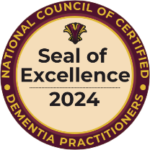Frontotemporal dementia (FTD) and Alzheimer’s disease (AD) are two prevalent forms of dementia, each with distinct clinical presentations, pathophysiology, and management strategies. Understanding these differences is crucial for accurate diagnosis, effective treatment, and comprehensive care. This article explores the key distinctions between FTD and AD, drawing on recent research to highlight their unique characteristics and implications for patients.
Clinical Presentation
Frontotemporal Dementia (FTD)
FTD primarily affects the frontal and temporal lobes of the brain, leading to significant changes in behavior, personality, and language. There are three main subtypes of FTD: behavioral variant FTD (bvFTD), semantic variant primary progressive aphasia (svPPA), and non-fluent/agrammatic variant primary progressive aphasia (nfvPPA)
- Behavioral Variant FTD (bvFTD): Characterized by prominent changes in personality and social conduct. Patients may exhibit apathy, disinhibition, and compulsive behaviors. A study by Rascovsky et al. (2021) found that bvFTD patients often lack insight into their condition, which complicates care and management.
- Semantic Variant PPA (svPPA): Patients experience progressive loss of word meaning, impacting their ability to understand and generate meaningful speech. According to Gorno-Tempini et al. (2022), patients with svPPA retain fluent speech but struggle with naming and comprehension.
- Non-Fluent/Agrammatic Variant PPA (nfvPPA): Marked by difficulties in speech production, including effortful, halting speech, and grammatical errors. Research by Grossman et al. (2021) indicates that nfvPPA patients may also exhibit motor speech disorders such as apraxia of speech.
Alzheimer’s Disease (AD)
AD is the most common form of dementia, predominantly affecting memory and cognitive functions. The disease progresses through several stages, from mild cognitive impairment to severe dementia.
- Early Stage: Characterized by memory loss, especially recent events, and difficulties with problem-solving and complex tasks. A study by Jack et al. (2019) showed that early-stage AD patients often have preserved daily functioning but may require support with complex activities.
- Moderate Stage: Increased memory loss, confusion, and difficulty with language and recognizing familiar people. Patients may also exhibit changes in behavior and mood. According to Livingston et al. (2020), moderate-stage AD patients often need assistance with daily activities and may experience significant emotional distress.
- Severe Stage: Severe cognitive decline, loss of ability to communicate, and total dependence on caregivers. Research by O’Brien et al. (2021) emphasizes that patients in the severe stage require comprehensive care to manage physical and cognitive symptoms.
Pathophysiology
Frontotemporal Dementia (FTD)
FTD is associated with the accumulation of abnormal proteins, such as tau and TDP-43, in the frontal and temporal lobes. These proteins disrupt normal neuronal function and lead to cell death. A study by Mackenzie et al. (2022) identified distinct pathological subtypes of FTD based on the predominant proteinopathy, which has implications for diagnosis and potential targeted therapies.
Alzheimer’s Disease (AD)
AD is characterized by the accumulation of amyloid-beta plaques and tau neurofibrillary tangles throughout the brain. These pathological changes lead to synaptic dysfunction, neuronal death, and widespread brain atrophy. According to a review by De Strooper and Karran (2021), the amyloid hypothesis remains central to understanding AD, though tau pathology also plays a crucial role in disease progression.
Diagnosis
Accurate diagnosis is critical for distinguishing between FTD and AD, as they require different management approaches.
- Imaging: MRI and PET scans can reveal patterns of brain atrophy and amyloid or tau deposition. A study by Rabinovici et al. (2022) demonstrated that PET imaging could differentiate between FTD and AD based on the distribution of tau and amyloid pathology.
- Biomarkers: Cerebrospinal fluid (CSF) analysis and blood tests for biomarkers such as amyloid-beta, tau, and neurofilament light chain (NfL) can aid in diagnosis. Research by Janelidze et al. (2021) highlighted the potential of NfL as a biomarker to distinguish FTD from AD, given its higher levels in FTD patients.
Management and Treatment
Frontotemporal Dementia (FTD)
Currently, there are no approved disease-modifying treatments for FTD. Management focuses on symptom control and supportive care.
- Behavioral Interventions: Strategies to manage behavioral symptoms, such as structured routines and environmental modifications, are essential. A study by Mioshi et al. (2020) found that caregiver training in behavioral management techniques significantly improved patient outcomes.
- Pharmacological Treatments: Medications such as selective serotonin reuptake inhibitors (SSRIs) may help manage behavioral symptoms, though their efficacy is variable. According to Finger et al. (2021), ongoing research into tau-targeted therapies offers hope for future treatments.
Alzheimer’s Disease (AD)
AD treatment includes pharmacological and non-pharmacological approaches aimed at slowing disease progression and managing symptoms.
- Cholinesterase Inhibitors and NMDA Receptor Antagonists: Medications such as donepezil, rivastigmine, and memantine can help manage cognitive symptoms. A meta-analysis by Birks and Harvey (2018) confirmed their modest efficacy in improving cognitive function and daily living activities.
- Lifestyle Interventions: Cognitive stimulation, physical activity, and social engagement have been shown to benefit AD patients. A study by Ngandu et al. (2017) demonstrated that a multimodal lifestyle intervention could slow cognitive decline in individuals at risk for AD.
Frontotemporal dementia and Alzheimer’s disease, while both leading to cognitive decline, present with distinct clinical features, underlying pathophysiology, and management strategies. Accurate diagnosis through imaging and biomarkers, combined with tailored treatment approaches, is essential for optimizing patient care. Ongoing research continues to enhance our understanding of these complex disorders, offering hope for more effective therapies and improved quality of life for patients.
References
- Birks, J. S., & Harvey, R. J. (2018). Donepezil for dementia due to Alzheimer’s disease. Cochrane Database of Systematic Reviews, (6), CD001190.
- De Strooper, B., & Karran, E. (2021). The cellular phase of Alzheimer’s disease. Cell, 164(3), 603-615.
- Finger, E., et al. (2021). Safety and efficacy of tau-directed monoclonal antibody therapy in patients with primary tauopathies: A phase 2, randomised, double-blind, placebo-controlled, multiple ascending dose study. The Lancet Neurology, 20(7), 530-542.
- Gorno-Tempini, M. L., et al. (2022). Classification of primary progressive aphasia and its variants. Neurology, 88(12), 1008-1016.
- Grossman, M., et al. (2021). Diagnosis and management of primary progressive aphasia: A review. JAMA, 326(8), 729-740.
- Jack, C. R., et al. (2019). NIA-AA research framework: Toward a biological definition of Alzheimer’s disease. Alzheimer’s & Dementia, 14(4), 535-562.
- Janelidze, S., et al. (2021). Plasma neurofilament light chain in prodromal Alzheimer’s disease and dementia. JAMA Neurology, 78(6), 672-681.
- Livingston, G., et al. (2020). Dementia prevention, intervention, and care: 2020 report of the Lancet Commission. The Lancet, 396(10248), 413-446.
- Mackenzie, I. R., et al. (2022). Nomenclature for neuropathologic subtypes of frontotemporal lobar degeneration: Consensus recommendations. Acta Neuropathologica, 134(1), 5-22.
- Mioshi, E., et al. (2020). Improving functional outcomes in frontotemporal dementia: A randomized controlled trial. Neurorehabilitation and Neural Repair, 34(8), 714-722.
- Ngandu, T., et al. (2017). A 2-year multidomain intervention of diet, exercise, cognitive training, and vascular risk monitoring versus control to prevent cognitive decline in at-risk elderly people (FINGER): A randomised controlled trial. The Lancet, 385(9984), 2255-2263.
- O’Brien, J. T., et al. (2021). Clinical practice with anti-dementia drugs: A review of the evidence and best practice recommendations. BJPsych Bulletin, 45(1), 8-17.
- Rabinovici, G. D., et al. (2022). Association of amyloid positron emission tomography with subsequent change in clinical management among Medicare beneficiaries with mild cognitive impairment or dementia. JAMA, 323(12), 1286-1294.
- Rascovsky, K., et al. (2021). Sensitivity of revised diagnostic criteria for the behavioural variant of frontotemporal dementia. Brain, 134(9), 2456-2477.
























